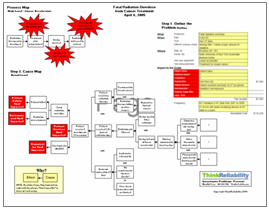Recently, we posted two blogs about medical radiation overdoses resulting from cancer overdoses – a patient who overdosed on radiation therapy for breast cancer, and a second patient who overdosed on intensity modulated radiation therapy for tongue cancer. Because of the risk of these types of incidents, proper control of radiation in medical settings has become a high priority for several investigations. Recently, the U.S. Food and Drug Administration (FDA) released an initiative to control unnecessary radiation exposure from medical imaging. Many of the initiatives to reduce exposure from medical imaging can also be applied to reduce exposure from
radiation therapy.
We will look at one of our previous blogs – the intensity modulated radiation therapy overdose – and discuss how the initiatives proposed by the FDA may have prevented the death of Scott Jerome-Parks. There are two radiation protection concepts for the initiatives – justification for use of radiation-related procedures, and optimization of the dose during the procedures.
 The justification portion of the initiative aims to ensure medical justification and informed decision-making by patients and their doctors. In order for the decisions to be informed, the FDA notes that patients must have comprehensive understanding of both the risks and benefits of the use of radiation. If patients were more aware of the risks of the use of radiation, it’s possible that Jerome-Parks and others would have chosen alternative approaches or would have selected facilities based on their experience or safety rating. Currently, because reporting requirements for errors involving radiation are inconsistent (or there are none at all), it’s nearly impossible for patients to make these sorts of comparisons.
The justification portion of the initiative aims to ensure medical justification and informed decision-making by patients and their doctors. In order for the decisions to be informed, the FDA notes that patients must have comprehensive understanding of both the risks and benefits of the use of radiation. If patients were more aware of the risks of the use of radiation, it’s possible that Jerome-Parks and others would have chosen alternative approaches or would have selected facilities based on their experience or safety rating. Currently, because reporting requirements for errors involving radiation are inconsistent (or there are none at all), it’s nearly impossible for patients to make these sorts of comparisons.
Another issue raised by the Jerome-Parks case is the lack of safeguards on the radiation equipment itself. Jerome-Parks received seven times the radiation dose on three occasions, and nobody noticed. The FDA proposes that equipment designed to deliver radiation be equipped with safeguards that optimize radiation doses and/or provide alerts when radiation exceeds a reference level or range. These safeguards would alert providers when radiation doses are higher than expected, giving them another chance to verify that the settings are correct. Hopefully this will prevent many occurrences of radiation overdose.
The FDA has also noted the lack of training and quality assurance practices for some radiation delivery practitioners. Several medical organizations are attempting to create standardized training and quality assurance methods to provide practitioners with the information they need to properly use radiation delivery equipment. The FDA is also planning to partner with the Center for Medicare and Medicaid Services (CMS) to incorporate appropriate quality assurance practices into accreditation and participation criteria for medical facilities, further
supporting the safe use of radiation delivery equipment.
Looking at the two previous radiation overdose cases, we can see the detrimental effect of radiation therapy when not used properly. Because of the great potential impact to patient safety, all involved parties MUST work together to ensure less patient risk from radiation therapy.


